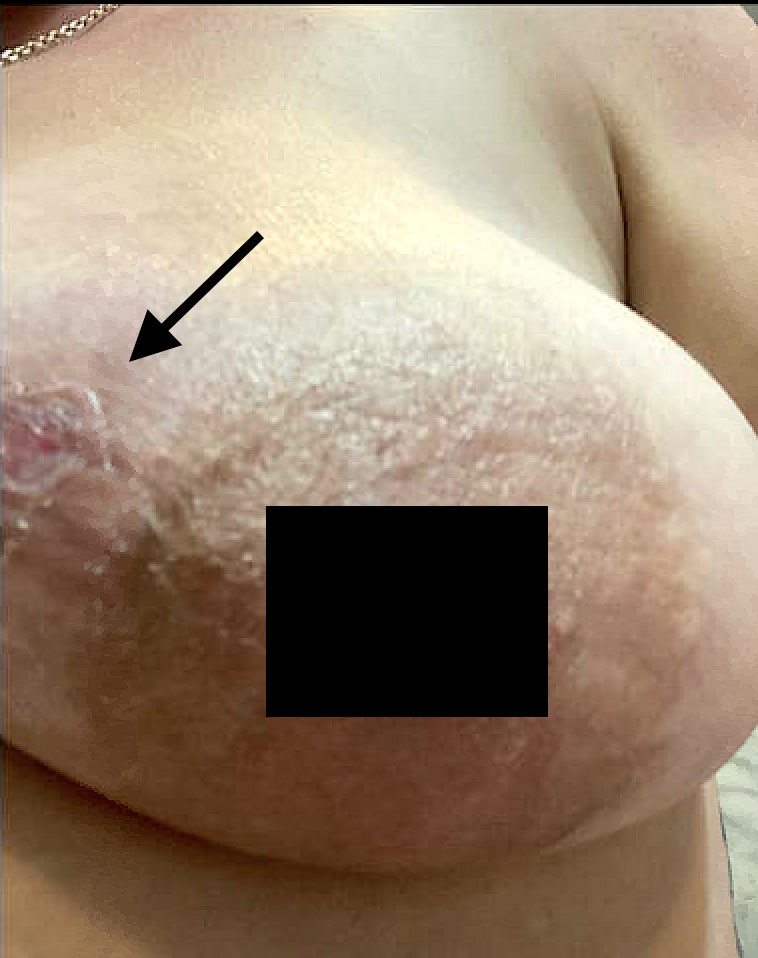Tuesday Poster Session
Category: IBD
P5523 - Granulomatous Mastitis as a Rare Extraintestinal Manifestation of Crohn’s Disease: A Case Report
Tuesday, October 28, 2025
10:30 AM - 4:00 PM PDT
Location: Exhibit Hall
.jpg)
Isaac Giovannie, MD
Rush University Medical Center
Chicago, IL
Presenting Author(s)
Giovannie Isaac-Coss, MD1, Meghana Kakarla, MD2, Atsushi Sakuraba, MD, PhD1, Melika Kooshki Forooshani, MD1, Maham Lodhi, MD1
1Rush University Medical Center, Chicago, IL; 2Infirmary Health, Mobile, AL
Introduction: Crohn’s disease (CD) is a chronic inflammatory disorder of the gastrointestinal tract, often marked by non-caseating granulomas. Up to 40% of patients develop extraintestinal manifestations (EIMs), commonly affecting the skin, joints, eyes, or hepatobiliary system. Granulomatous mastitis (GM) is a rare inflammatory breast disease, typically linked to autoimmune conditions or infections but rarely reported in CD. We present a case of biopsy-proven GM in longstanding CD, highlighting its recognition as an underappreciated EIM.
Case Description/
Methods: A 44-year-old woman, diagnosed with CD at age 14 after ileocecal resection for gangrenous bowel, presented to re-establish gastroenterology care after years off IBD therapy. Past treatments included mesalamine, budesonide, infliximab (discontinued due to allergic reactions), certolizumab, and adalimumab (stopped due to cutaneous adverse events), ultimately stopping therapy by 2007. She later developed rheumatoid arthritis and hidradenitis suppurativa but remained off biologics.
In late 2024, she presented with recurrent left breast abscesses unresponsive to antibiotics (image 1). Surgical drainage and punch biopsy revealed non-necrotizing GM, with negative special stains for bacteria, fungi, or acid-fast organisms (image 2). Breast surgery and rheumatology started corticosteroids, later transitioning to secukinumab (an IL-17 inhibitor) with partial improvement. She remains an active smoker. Currently, she reports no gastrointestinal symptoms, and a 2025 colonoscopy showed no active inflammation. From the gastroenterology standpoint, we plan to initiate an IL-23 inhibitor, which has proven efficacy in CD, unlike IL-17 inhibitors.
Discussion: Although EIMs are well described in CD, breast involvement is exceedingly rare. Importantly, EIMs can progress independently of intestinal disease, meaning patients may be asymptomatic from CD yet experience active EIMs. While IL-17 inhibitors like secukinumab are effective for skin and joint diseases, they have shown no benefit for CD and may even worsen intestinal and extraintestinal inflammation by disrupting gut epithelial integrity and amplifying mucosal immune responses. This case highlights the need to recognize GM as a potential EIM and to select biologic therapies with proven efficacy in CD. It underscores the importance of multidisciplinary collaboration among gastroenterology, rheumatology, dermatology, and surgery to ensure coordinated, disease-specific care.

Figure: Granulomatous mastitis of left breast (black arrow), obtained and presented with permission of patient.

Figure: H&E, 10x. Histopathological section showing non-caseating granulomas (black arrow) within breast tissue, consistent with granulomatous mastitis as an extraintestinal manifestation of Crohn’s disease.
Disclosures:
Giovannie Isaac-Coss indicated no relevant financial relationships.
Meghana Kakarla indicated no relevant financial relationships.
Atsushi Sakuraba indicated no relevant financial relationships.
Melika Kooshki Forooshani indicated no relevant financial relationships.
Maham Lodhi indicated no relevant financial relationships.
Giovannie Isaac-Coss, MD1, Meghana Kakarla, MD2, Atsushi Sakuraba, MD, PhD1, Melika Kooshki Forooshani, MD1, Maham Lodhi, MD1. P5523 - Granulomatous Mastitis as a Rare Extraintestinal Manifestation of Crohn’s Disease: A Case Report, ACG 2025 Annual Scientific Meeting Abstracts. Phoenix, AZ: American College of Gastroenterology.
1Rush University Medical Center, Chicago, IL; 2Infirmary Health, Mobile, AL
Introduction: Crohn’s disease (CD) is a chronic inflammatory disorder of the gastrointestinal tract, often marked by non-caseating granulomas. Up to 40% of patients develop extraintestinal manifestations (EIMs), commonly affecting the skin, joints, eyes, or hepatobiliary system. Granulomatous mastitis (GM) is a rare inflammatory breast disease, typically linked to autoimmune conditions or infections but rarely reported in CD. We present a case of biopsy-proven GM in longstanding CD, highlighting its recognition as an underappreciated EIM.
Case Description/
Methods: A 44-year-old woman, diagnosed with CD at age 14 after ileocecal resection for gangrenous bowel, presented to re-establish gastroenterology care after years off IBD therapy. Past treatments included mesalamine, budesonide, infliximab (discontinued due to allergic reactions), certolizumab, and adalimumab (stopped due to cutaneous adverse events), ultimately stopping therapy by 2007. She later developed rheumatoid arthritis and hidradenitis suppurativa but remained off biologics.
In late 2024, she presented with recurrent left breast abscesses unresponsive to antibiotics (image 1). Surgical drainage and punch biopsy revealed non-necrotizing GM, with negative special stains for bacteria, fungi, or acid-fast organisms (image 2). Breast surgery and rheumatology started corticosteroids, later transitioning to secukinumab (an IL-17 inhibitor) with partial improvement. She remains an active smoker. Currently, she reports no gastrointestinal symptoms, and a 2025 colonoscopy showed no active inflammation. From the gastroenterology standpoint, we plan to initiate an IL-23 inhibitor, which has proven efficacy in CD, unlike IL-17 inhibitors.
Discussion: Although EIMs are well described in CD, breast involvement is exceedingly rare. Importantly, EIMs can progress independently of intestinal disease, meaning patients may be asymptomatic from CD yet experience active EIMs. While IL-17 inhibitors like secukinumab are effective for skin and joint diseases, they have shown no benefit for CD and may even worsen intestinal and extraintestinal inflammation by disrupting gut epithelial integrity and amplifying mucosal immune responses. This case highlights the need to recognize GM as a potential EIM and to select biologic therapies with proven efficacy in CD. It underscores the importance of multidisciplinary collaboration among gastroenterology, rheumatology, dermatology, and surgery to ensure coordinated, disease-specific care.

Figure: Granulomatous mastitis of left breast (black arrow), obtained and presented with permission of patient.

Figure: H&E, 10x. Histopathological section showing non-caseating granulomas (black arrow) within breast tissue, consistent with granulomatous mastitis as an extraintestinal manifestation of Crohn’s disease.
Disclosures:
Giovannie Isaac-Coss indicated no relevant financial relationships.
Meghana Kakarla indicated no relevant financial relationships.
Atsushi Sakuraba indicated no relevant financial relationships.
Melika Kooshki Forooshani indicated no relevant financial relationships.
Maham Lodhi indicated no relevant financial relationships.
Giovannie Isaac-Coss, MD1, Meghana Kakarla, MD2, Atsushi Sakuraba, MD, PhD1, Melika Kooshki Forooshani, MD1, Maham Lodhi, MD1. P5523 - Granulomatous Mastitis as a Rare Extraintestinal Manifestation of Crohn’s Disease: A Case Report, ACG 2025 Annual Scientific Meeting Abstracts. Phoenix, AZ: American College of Gastroenterology.
